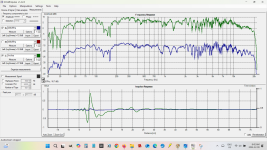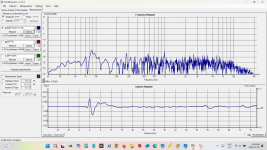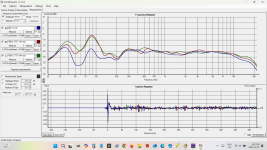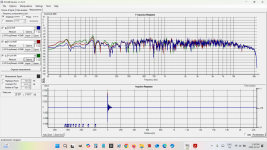I read somewhere that a hump around 600 hz will sound boxy and that more stuffing can help with that or a rise around 3000 may sound strident and needs a resistor what are some other freqency response deviations and the effect and solution. Just curious and I spent quite a bit of time looking for this information and really cannot find much. I have a average 5 db dip between 100 and 200 at the listening position not sure what this causes or how to fix it.
This may help with describing the sound.
https://www.stereophile.com/reference/50/index.html
But your dip may be "floor bounce" cancellation.
https://www.stereophile.com/reference/50/index.html
But your dip may be "floor bounce" cancellation.
A peak or dip anywhere can be a problem.. some more than others. A peak that sounds boxy doesn't have to be caused by your box. If only it were that simple 😉 Sometimes you have to work out where in the room it is coming from.
Sometimes a dip in the lower hundreds can result from your baffle step, broadly speaking.
Sometimes a dip in the lower hundreds can result from your baffle step, broadly speaking.
Could be a room mode or floor bounce issue (different path lengths for direct vs reflected energy from the speaker). Have you optimized the speaker position and listening position to smooth in-room response? Have you tried elevating the speaker to see if the dip changes? Have you averaged several readings around the listening position to make sure the dip is not highly position dependent?
Some of this is expected in real rooms and tends not to sound as bad as it measures, assuming the speaker has good power response.
While equalization can help in the lower frequencies, boosting to fill a deep hole is generally not done since power demands can get out of hand.
Some of this is expected in real rooms and tends not to sound as bad as it measures, assuming the speaker has good power response.
While equalization can help in the lower frequencies, boosting to fill a deep hole is generally not done since power demands can get out of hand.
Last edited:
thank you all the stereophile article is great and very helpful. It does a pretty good job of explaining the issues at different frequencies.
thank you for the advice on floor bounce. I have a old
primare pre pro without the ability to use EQ.
When I built the speakers I may have ended up with an unintentional resonance at about 150hz here is the raw graph taken outside with stuffing and without I suppose I could add more stuffing. Here is the best location measurements. and the current location measurements with and without sub.
I guess what I am asking is what am I missing in the music from the dip at 200 hz the system sounds great to me. imaging and soundstage are excellent the bass was light in the prefered LP so I added the sub.
thank you for the advice on floor bounce. I have a old
primare pre pro without the ability to use EQ.
When I built the speakers I may have ended up with an unintentional resonance at about 150hz here is the raw graph taken outside with stuffing and without I suppose I could add more stuffing. Here is the best location measurements. and the current location measurements with and without sub.
I guess what I am asking is what am I missing in the music from the dip at 200 hz the system sounds great to me. imaging and soundstage are excellent the bass was light in the prefered LP so I added the sub.
Attachments
A nearfield measurement of the woofer can also help show where the problem is, especially if you have a single driver covering the range where the dip is. Put the microphone about 1/4 inch from the woofer's cone and check frequency response. Keep the level relatively low, so you aren't above about 110 dB at the microphone. If frequency response is smooth at that distance, it's unlikely that your dip is a problem in the speaker. You can check the port output the same way (assuming you have one).
Even outdoors, if you aren't using ground plane methods, a significantly elevated measurement, etc., it's hard to measure lower frequencies accurately at a distance.
Even outdoors, if you aren't using ground plane methods, a significantly elevated measurement, etc., it's hard to measure lower frequencies accurately at a distance.
.Thank you I tested on it side and the dip is still there but the woofers would be approx the same distance from the ground. it is an mtm speaker. the woofers alone and the port do not show any sign of a dip at the 200hz in fact the port has a peak there.
If the port's peak at 200 Hz is out of phase with the woofer at that frequency and at a high enough level, it could be decreasing overall output in that range. A quick way to test that idea is to temporarily plug the port and see if the frequency response at the listening position improves or stays the same in that range. You should take new measurements in both conditions so the microphone is in the same spot for both. Some rolled up socks, a piece of squishy foam, or whatever is handy and fits can be used to block the port.
I read somewhere that a hump around 600 hz will sound boxy...
Per the image above, "Boxy" is 600hz, so at least someone agrees with that.
Maybe the chart provided here will help.I read somewhere that a hump around 600 hz will sound boxy and that more stuffing can help with that or a rise around 3000 may sound strident and needs a resistor what are some other freqency response deviations and the effect and solution. Just curious and I spent quite a bit of time looking for this information and really cannot find much.
https://diyaudioheaven.wordpress.com/wp-content/uploads/2019/04/descriptors2.png
Interestingly enough the sock lead me to remove the port. Hornresp called out a shorter port and removing the port helped quite a bit. With the sub I do not have to worry about the bottom end. this is without the sub. thank you again the charts are great just what I was looking for. I spent a lot of time looking but could not find that information.
Attachments
Depending on the size and location of the port, port geometry, etc., you could have been leaking reflected energy from inside the cabinet or there could have been pipe resonance issues within the port itself. Each kind of problem tends to have different solutions, so figuring out the root cause is often necessary to deal effectively with something like this, and absorbing such low frequencies can be hard. In your case, foregoing the port is probably the most expedient solution, and if you're happy with it that's all that really matters in the end.
- Home
- Loudspeakers
- Multi-Way
- impact of frequency response humps and nulls



